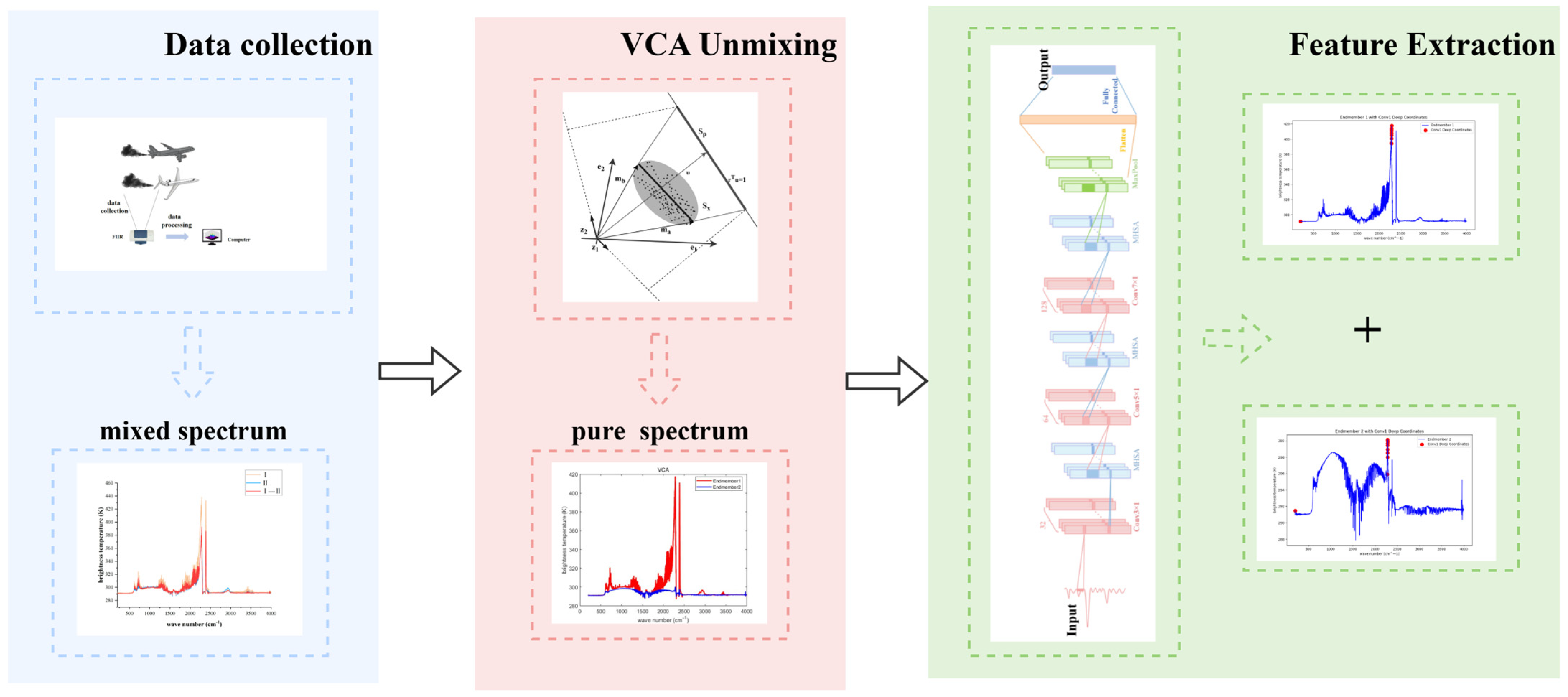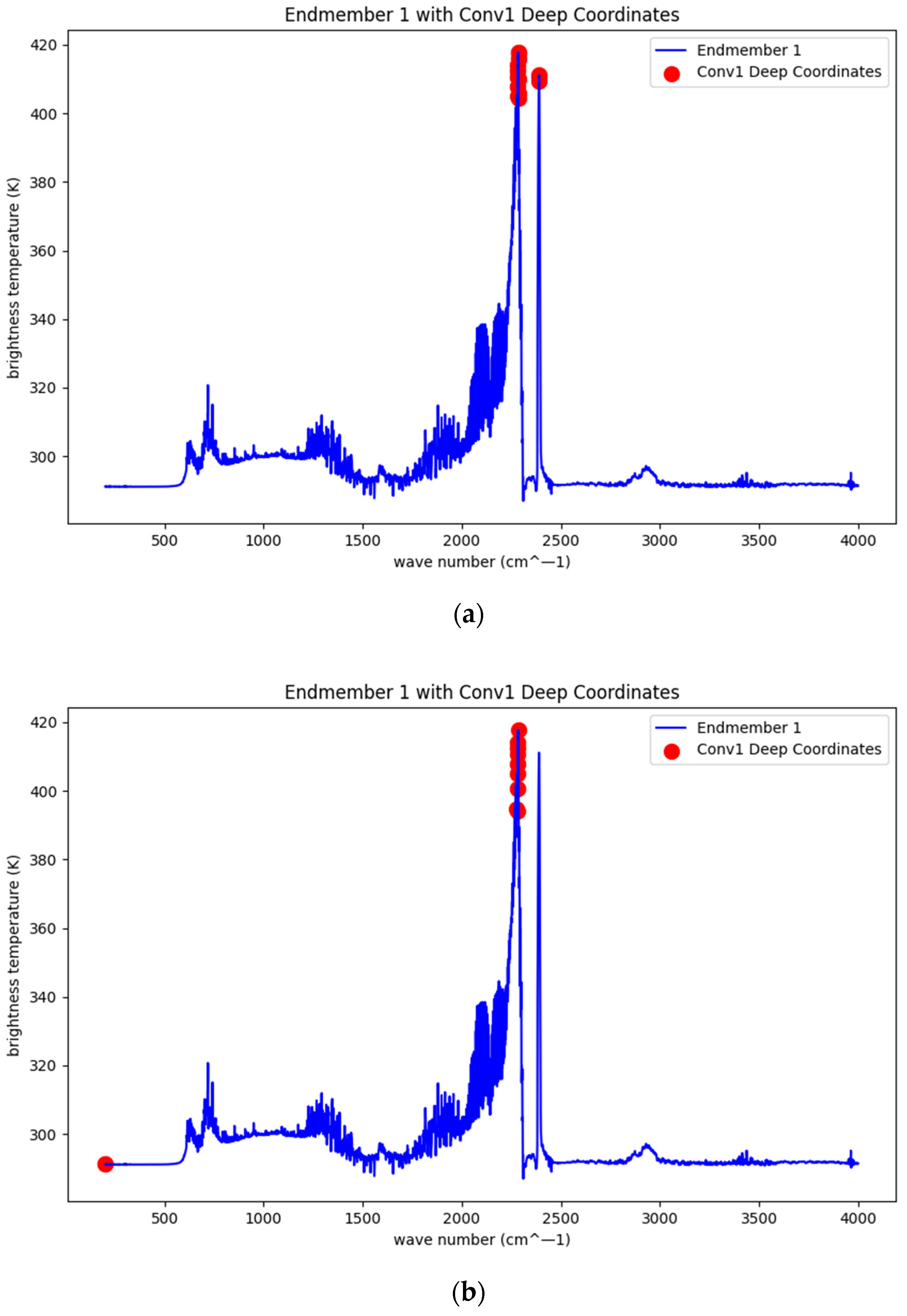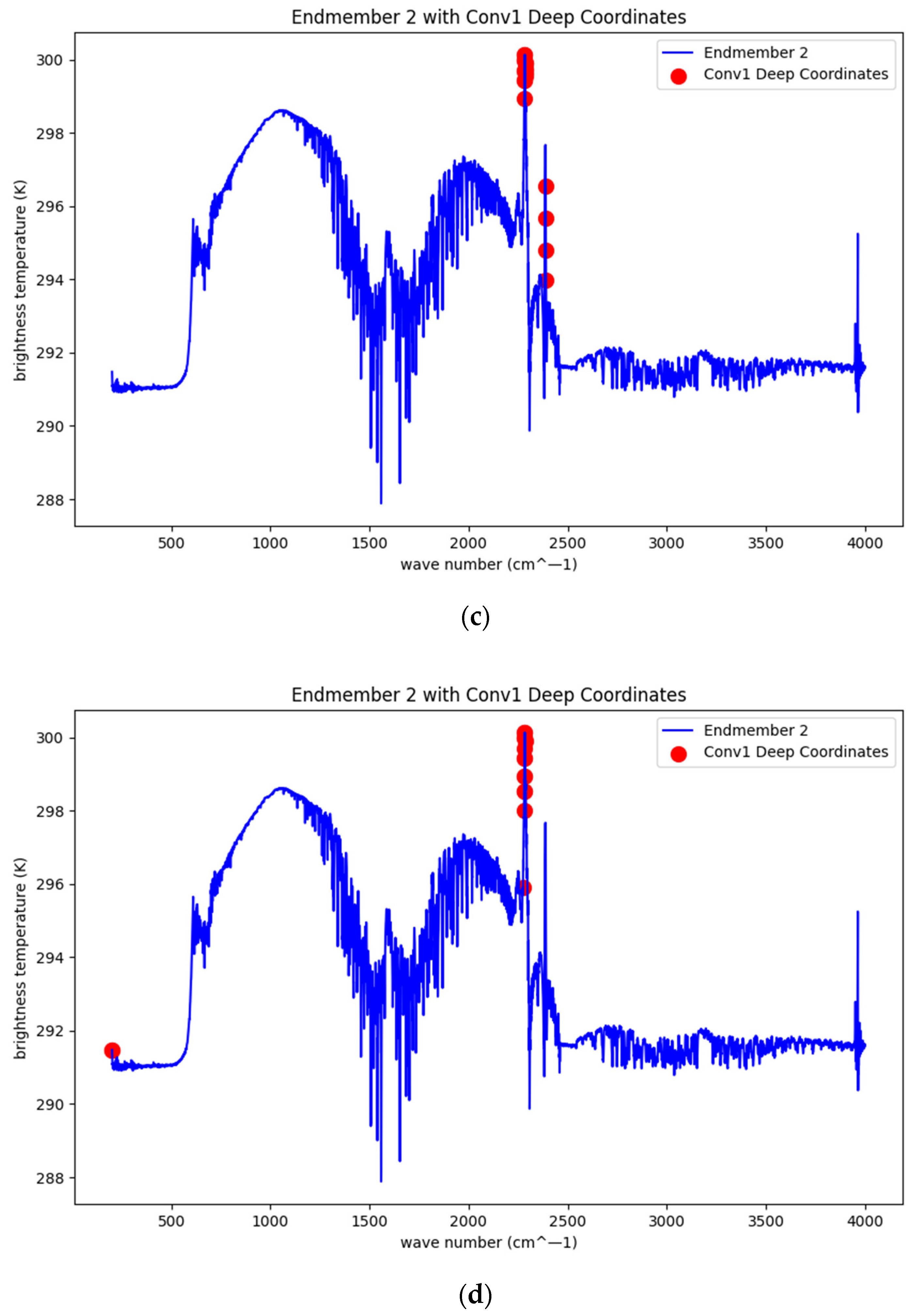A VCA Combined MHSA-CNN for Aero-Engine Hot Jet Remote Sensing Mixed Spectral Feature Extraction
Abstract
1. Introduction
- Fourier infrared spectrometry is used to accurately measure the hot jets of two different types of aero-engines. The collected data include the hot jet spectra generated separately by each type of engine and the spectral information of the mixed hot jets of the two types of engines.
- Combined with the VCA method in statistics, the VCA algorithm is proposed to carry out the unmixing operation on the mixed spectra of the hot jets of two aero-engines. The independent pure spectra of the hot jets of two engines are successfully obtained through VCA, and the proportion of each pure spectrum in the mixed spectrum is calculated, which lays a solid foundation for the subsequent in-depth analysis.
- A one-dimensional convolutional deep learning MHSA-CNN algorithm is proposed. In order to grasp the intrinsic characteristics and differences of two different types of aero-engine hot jets more accurately, the algorithm extracts the features of the two types of aero-engine hot jets after unmixing. This provides powerful data support and technical guarantee for aero-engine fault diagnosis.
2. Aero-Engine Hot Jet Spectrum Data Collection
3. Remote Sensing Mixed Spectral Feature Extraction Network for Aero-Engine Hot Jet
3.1. VCA Method for Mixed Spectral Unmixing
- The mean of the brightness temperature of all samples for each wave number is calculated for all the aero-engine hot jet mixing spectral data.
- The mean value corresponding to each wave number is subtracted from the data, and the DC component in the data is removed to obtain zero mean data. The purpose of this is to reduce errors that can be caused by data offset or background light, etc., so that our model only focuses on the intrinsic characteristics of the data.
- The 2-dimensional projection matrix is calculated by SVD decomposition, and the zero-mean data of the previous step is projected into the 2-dimensional subspace to obtain the projected data and the original data :
- The SNR threshold and are calculated according to the following formula:
- 5.
- If , indicating that the signal-to-noise ratio is low, the project is projected into the 1-dimensional subspace to filter the noise. If , indicating that the signal-to-noise ratio is high, it is projected into the 2-dimensional subspace to preserve the complete spectral characteristics.
- 6.
- The matrix is normalized for subsequent VCA unmixing.
- Set the number of endmembers p = 2;
- Choose an initial vector at random, making sure that there are no observed vectors orthogonal to ;
- Initialize projection correlation parameters such that = I;
- Calculate projection vectors for all mixed spectral data vectors:
- In the projection results of all samples, to find the vector corresponding to the most “prominent” sample in the projection direction, we use the Euclidean norm as the selection criterion. Find the vector with the largest norm in the projection vector , and define its corresponding mixed spectral data vector as the first endmember estimate :
- , where is the matrix from which we construct our found endmember estimates;
- In order to project all the data vectors in directions that have been found to be orthogonal to the first endmember , the projection matrix is computed:
- Calculate the projection vectors of all the mixed spectral data vectors:
- Also using the Euclidean norm, we find the vector with the largest norm in the projection vector , and define it as the second end element estimate corresponding to the mixed spectral data vector .
3.2. Feature Extraction Network MHSA-CNN
4. Experiment
4.1. Spectral Unmixing
4.2. Spectral Feature Extraction
5. Discussion
6. Conclusions
Author Contributions
Funding
Data Availability Statement
Conflicts of Interest
References
- Chen, Y.; Zhang, W.; Zhao, Z.; Tsoutsanis, E.; Malkogianni, A.; Ma, Y.; Gou, L. Actuator fault diagnosis and severity identification of turbofan engines for steady-state and dynamic conditions. Chin. J. Aeronaut. 2025, 38, 103243. [Google Scholar]
- Shen, P.; Bi, F.; Bi, X.; Guo, M.; Lu, Y. Piston aero-engine fault cross-domain diagnosis based on unpaired generative transfer learning. Eng. Appl. Artif. Intell. 2024, 137, 109159. [Google Scholar]
- Liao, Z.; Zhan, K.; Zhao, H.; Deng, Y.; Geng, J.; Chen, X.; Song, Z. Addressing class-imbalanced learning in real-time aero-engine gas-path fault diagnosis via feature filtering and mapping. Reliab. Eng. Syst. Saf. 2024, 249, 110189. [Google Scholar]
- Ni, Q.; Zuo, Y.; Zhi, Z.; Shi, Y.; Liu, G.; Ou, Q. Diagnosis of corn leaf diseases by FTIR spectroscopy combined with machine learning. Vib. Spectrosc. 2024, 135, 103744. [Google Scholar]
- Lafi, A.G.A.; Naser, I.; Abboud, H. Application of two dimensional correlation Fourier Transform Infrared spectroscopy (2D-COS-FTIR) to the quantification of carbohydrates in milk powder. J. Food Compos. Anal. 2024, 134, 106541. [Google Scholar]
- Kryska, A.; Depciuch, J.; Krysa, M.; Paja, W.; Wosiak, A.; Nicoś, M.; Budzynska, B.; Bartnicka, A.S. Lipids balance as a spectroscopy marker of diabetes. Analysis of FTIR spectra by 2D correlation and machine learning analyses. Spectrochim. Acta Part A Mol. Biomol. Spectrosc. 2024, 320, 124653. [Google Scholar]
- Rios, T.G.; Larios, G.; Marangoni, B.; Oliveira, S.L.; Cena, C.; Ramos, C.A.D.N. FTIR spectroscopy with machine learning: A new approach to animal DNA polymorphism screening. Spectrochim. Acta Part A Mol. Biomol. Spectrosc. 2021, 261, 120036. [Google Scholar]
- Congedo, M.; Gouy-Pailler, C.; Jutten, C. On the blind source separation of human electroencephalogram by approximate joint diagonalization of second order statistics. Clin. Neurophysiol. 2008, 119, 119,2677–2686. [Google Scholar]
- Braak, H.; Braak, E. Neuropathological staging of Alzheimer-related changes. Acta Neuropathol. 1991, 82, 239–259. [Google Scholar]
- Moussaoui, S.; Hauksdottir, H.; Schmidt, F.; Jutten, C.; Chanussot, J.; Brie, D.; Doute, S.; Benediktsson, J.A.J.N. On the decomposition of Mars hyperspectral data by ICA and Bayesian positive source separation. Neurocomputing 2008, 71, 2194–2208. [Google Scholar]
- Du, H.; Qi, H.J.I. An FPGA implementation of parallel ICA for dimensionality reduction in hyperspectral images. In Proceedings of the IGARSS 2004. 2004 IEEE International Geoscience and Remote Sensing Symposium, Anchorage, AK, USA, 20–24 September 2004. [Google Scholar]
- Nascimento, J.M.; Dias, J.M. Vertex component analysis: A fast algorithm to unmix hyperspectral data. IEEE Trans. Geosci. Remote Sens. 2005, 43, 898–910. [Google Scholar]
- Lee, D.D.; Seung, H.S.J.N. Learning the parts of objects by non-negative matrix factorization. Nature 1999, 401, 788–791. [Google Scholar] [PubMed]
- Smaragdis, P.; Fevotte, C.; Mysore, G.J.; Mohammadiha, N.; Hoffman, M. Static and Dynamic Source Separation Using Nonnegative Factorizations: A unified view. IEEE Signal Process. Mag. 2014, 31, 66–75. [Google Scholar]
- Ren, L.; Ma, Z.; Bovolo, F.; Hu, J.; Bruzzone, L. Hyperspectral unmixing using weighted sparse regression with total variation regularization. Int. J. Remote Sens. 2022, 43, 6124–6151. [Google Scholar]
- Bioucas-Dias, J.M.; Plaza, A.; Dobigeon, N.; Parente, M.; Du, Q.; Gader, P.; Chanussot, J. Hyperspectral Unmixing Overview: Geometrical, Statistical, and Sparse Regression-Based Approaches. IEEE J. Sel. Top. Appl. Earth Obs. Remote Sens. 2012, 5, 354–379. [Google Scholar]
- Rosipal, R.; Girolami, M.; Trejo, L.J.; Cichocki, A. Kernel PCA for Feature Extraction and De-Noising in Nonlinear Regression. Neural Comput. Appl. 2001, 10, 231–243. [Google Scholar]
- Carlo, L.; Michel, T.; Vincenzo Esposito, V.; Yvesmarie, C. PLS path modeling. Comput. Stat. Data Anal. 2005, 48, 159–205. [Google Scholar]
- Cococcioni, M.; De Gironcoli, S. A linear response approach to the calculation of the effective interaction parameters in the LDA+U method. Phys. Rev. B-Condens. Matter Mater. Phys. 2004, 71, 035105. [Google Scholar]
- Lu, J.; Plataniotis, K.N.; Venetsanopoulos, A.N. Face Recognition Using LDA-Based Algorithms. IEEE Trans. Neural Netw. 2003, 14, 195–200. [Google Scholar]
- Arshad, T.; Zhang, J.; Anyembe, S.C.; Mehmood, A. Spectral Spatial Neighborhood Attention Transformer for Hyperspectral Image Classification. Can. J. Remote Sens. 2024, 50, 2347631. [Google Scholar]
- Cui, B.; Wen, J.; Song, X.; He, J. MADANet: A Lightweight Hyperspectral Image Classification Network with Multiscale Feature Aggregation and a Dual Attention Mechanism. Remote Sens. 2023, 15, 5222. [Google Scholar] [CrossRef]
- Li, Z.; Chen, G.; Li, G.; Zhou, L.; Pan, X.; Zhao, W.; Zhang, W. DBANet: Dual-branch Attention Network for hyperspectral remote sensing image classification. Comput. Electr. Eng. 2024, 118, 109269. [Google Scholar] [CrossRef]
- Ghazlane, Y.; Gmira, M.; Medromi, H. Development Of A Vision-based Anti-drone Identification Friend or Foe Model to Recognize Birds and Drones Using Deep Learning. Appl. Artif. Intell. 2024, 38, 2318672. [Google Scholar] [CrossRef]
- Li, H.; Tian, Z.; Li, X.; Arebi, P. Identifying effective nodes in term of the influence maximization on the social IoT networks using deep learning-based node embedding. Computing 2024, 107, 38. [Google Scholar] [CrossRef]
- Shang, D.; Lv, Z.; Gao, Z.; Li, Y. Detection of coal gangue by YOLO deep learning method based on channel pruning. Int. J. Coal Prep. Util. 2025, 45, 231–243. [Google Scholar] [CrossRef]
- Chowdary, M.K.; Priya, E.A.; Danciulescu, D.; Anitha, J.; Hemanth, D.J. Hybrid deep learning models based emotion recognition with speech signals. Intell. Decis. Technol. 2023, 17, 1435–1453. [Google Scholar] [CrossRef]
- Yadav, A.K.; Kumar, M.; Kumar, A.; Shivani; Kusum; Yadav, D. Hate speech recognition in multilingual text: Hinglish documents. Int. J. Inf. Technol. 2023, 15, 1319–1331. [Google Scholar]
- Pookpanich, P.; Siriborvornratanakul, T. Offensive language and hate speech detection using deep learning in football news live streaming chat on YouTube in Thailand. Soc. Netw. Anal. Min. 2024, 14, 18. [Google Scholar] [CrossRef]
- Alaghbari, K.A.; Lim, H.S.; Saad, M.H.; Yong, Y.S. Deep Autoencoder-Based Integrated Model for Anomaly Detection and Efficient Feature Extraction in IoT Networks. IoT 2023, 4, 345–365. [Google Scholar] [CrossRef]
- Demir, K.; Yaman, O. Applications. Projector deep feature extraction-based garbage image classification model using underwater images. Multimed. Tools Appl. 2024, 83, 79437–79451. [Google Scholar] [CrossRef]
- Chen, X.; Xing, X.; Zhang, Y.; Liu, R.; Li, L.; Zhang, R.; Tang, L.; Shi, Z.; Zhou, H.; Guo, R.; et al. MSCR-FuResNet: A Three-Residual Network Fusion Model Based on Multi-Scale Feature Extraction and Enhanced Channel Spatial Features for Close-Range Apple Leaf Diseases Classification under Optimal Conditions. Horticulturae 2024, 10, 953. [Google Scholar] [CrossRef]
- Ade, P.; Aghanim, N.; Arnaud, M.; Arroja, F.; Ashdown, M.; Aumont, J.; Baccigalupi, C.; Ballardini, M.; Banday, A.J.; Barreiro, R.B.J.S.C. Planck 2015 results: XX. Constraints Inflat. 2015, 16, 145–159. [Google Scholar]
- Du, S.; Han, W.; Kang, Z.; Lu, X.; Liao, Y.; Li, Z. Continuous Wavelet Transform Peak-Seeking Attention Mechanism Conventional Neural Network: A Lightweight Feature Extraction Network with Attention Mechanism Based on the Continuous Wave Transform Peak-Seeking Method for Aero-Engine Hot Jet Fourier Transform Infrared Classification. Remote Sens. 2024, 16, 3097. [Google Scholar] [CrossRef]
- Du, S.; Han, W.; Kang, Z.; Luo, F.; Liao, Y.; Li, Z. A Peak-Finding Siamese Convolutional Neural Network (PF-SCNN) for Aero-Engine Hot Jet FT-IR Spectrum Classification. Aerospace 2024, 11, 703. [Google Scholar] [CrossRef]
- Barnston, A.G. Correspondence among the Correlation, RMSE, and Heidke Forecast Verification Measures; Refinement of the Heidke Score. Weather. Forecast. 1992, 7, 699–709. [Google Scholar]
- Koper, M.T.; Lebedeva, N.P.; Hermse, C.G. Dynamics of CO at the solid/liquid interface studied by modeling and simulation of CO electro-oxidation on Pt and PtRu electrodes. Faraday Discuss. 2002, 121, 301–311. [Google Scholar]
- Bai, S.B.; Wang, J.; Lü, G.N.; Zhou, P.G.; Hou, S.S.; Xu, S.N. GIS-based logistic regression for landslide susceptibility mapping of the Zhongxian segment in the Three Gorges area, China. Geomorphology 2010, 115, 23–31. [Google Scholar]
- Schlerf, M.; Atzberger, C.; Hill, J. Remote sensing of forest biophysical variables using HyMap imaging spectrometer data. Remote Sens. Environ. 2005, 95, 177–194. [Google Scholar]
- McCormick, M.P.; Steele, H.M.; Hamill, P.; Chu, W.P.; Swissler, T.J. Polar Stratospheric Cloud Sightings by SAM II. J. Atmos. Sci. 1982, 39, 1387–1397. [Google Scholar] [CrossRef]
- Rasti, B.; Zouaoui, A.; Mairal, J.; Chanussot, J. Image Processing and Machine Learning for Hyperspectral Unmixing: An Overview and the HySUPP Python Package. IEEE Trans. Geosci. Remote Sens. 2024, 62, 5517631. [Google Scholar]
- Yu, Y.; Ma, Y.; Mei, X.; Fan, F.; Huang, J.; Li, H. Multi-stage convolutional autoencoder network for hyperspectral unmixing. Int. J. Appl. Earth Obs. Geoinf. 2022, 113, 102981. [Google Scholar]
- Heland, J.; Schäfer, K. Determination of major combustion products in aircraft exhausts by FTIR emission spectroscopy. Atmos. Environ. 1998, 32, 3067–3072. [Google Scholar]











| Model | Kernel Size | Kernels | Activation | Padding |
|---|---|---|---|---|
| conv1 | 3 | 32 | Relu | 1 |
| conv2 | 5 | 64 | Relu | 2 |
| conv3 | 7 | 128 | Relu | 3 |
Disclaimer/Publisher’s Note: The statements, opinions and data contained in all publications are solely those of the individual author(s) and contributor(s) and not of MDPI and/or the editor(s). MDPI and/or the editor(s) disclaim responsibility for any injury to people or property resulting from any ideas, methods, instructions or products referred to in the content. |
© 2025 by the authors. Licensee MDPI, Basel, Switzerland. This article is an open access article distributed under the terms and conditions of the Creative Commons Attribution (CC BY) license (https://creativecommons.org/licenses/by/4.0/).
Share and Cite
Kang, Z.; Liao, Y.; Yang, X.; Li, Z. A VCA Combined MHSA-CNN for Aero-Engine Hot Jet Remote Sensing Mixed Spectral Feature Extraction. Remote Sens. 2025, 17, 1147. https://doi.org/10.3390/rs17071147
Kang Z, Liao Y, Yang X, Li Z. A VCA Combined MHSA-CNN for Aero-Engine Hot Jet Remote Sensing Mixed Spectral Feature Extraction. Remote Sensing. 2025; 17(7):1147. https://doi.org/10.3390/rs17071147
Chicago/Turabian StyleKang, Zhenping, Yurong Liao, Xinyan Yang, and Zhaoming Li. 2025. "A VCA Combined MHSA-CNN for Aero-Engine Hot Jet Remote Sensing Mixed Spectral Feature Extraction" Remote Sensing 17, no. 7: 1147. https://doi.org/10.3390/rs17071147
APA StyleKang, Z., Liao, Y., Yang, X., & Li, Z. (2025). A VCA Combined MHSA-CNN for Aero-Engine Hot Jet Remote Sensing Mixed Spectral Feature Extraction. Remote Sensing, 17(7), 1147. https://doi.org/10.3390/rs17071147






